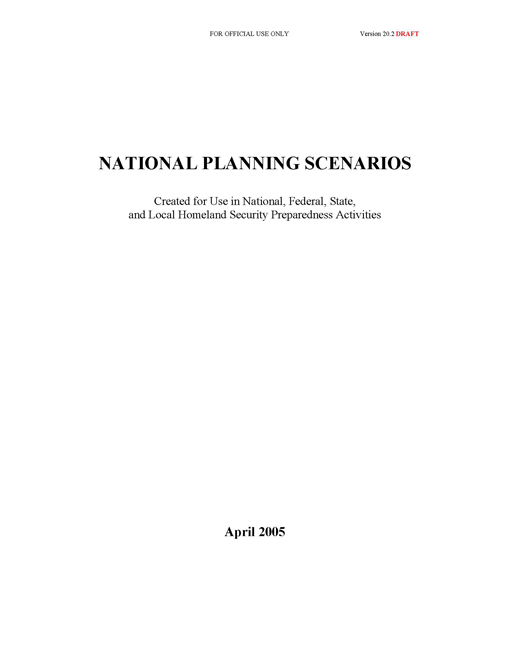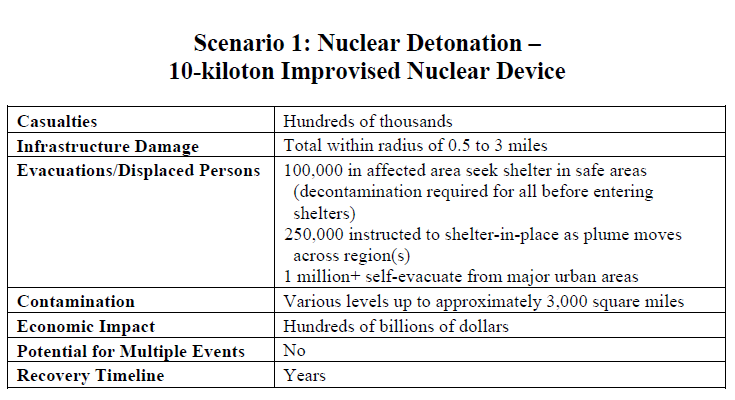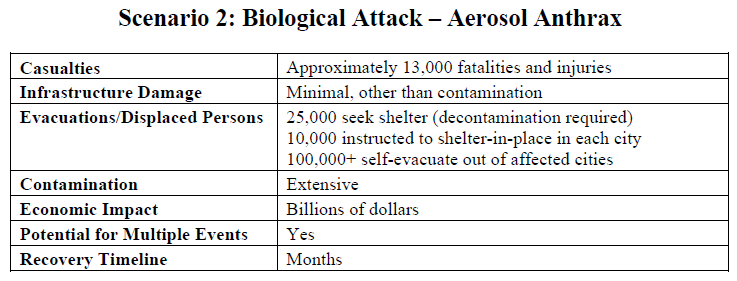Created for Use in National, Federal, State, and Local Homeland Security Preparedness Activities
- Version 20.2 Draft
- For Official Use Only
- 157 pages
- April 2005
Introduction
The Federal interagency community has developed fifteen all-hazards planning scenarios (the National Planning Scenarios or Scenarios) for use in national, Federal, State, and local homeland security preparedness activities. The Scenarios are planning tools and are representative of the range of potential terrorist attacks and natural disasters and the related impacts that face our nation. The objective was to develop a minimum number of credible scenarios in order to establish the range of response requirements to facilitate preparedness planning. Since these Scenarios were compiled to be the minimum number necessary to develop the range of response capabilities and resources, other hazards were inevitably omitted. Examples of other potentially high-impact events include nuclear power plant incidents1, industrial and transportation accidents, and frequently occurring natural disasters. Entities at all levels of government can use the National Planning Scenarios as a reference to help them identify the potential scope, magnitude, and complexity of potential major events. Entities are not precluded from developing their own scenarios to supplement the National Planning Scenarios. These Scenarios reflect a rigorous analytical effort by Federal homeland security experts, with reviews by State and local homeland security representatives. However, it is recognized that refinement and revision over time will be necessary to ensure the Scenarios remain accurate, represent the evolving all-hazards threat picture, and embody the capabilities necessary to respond to domestic incidents.
How to Use the National Planning Scenarios:
Capabilities-Based Planning
In seeking to prepare the Nation for terrorist attacks, major disasters and other emergencies, it is impossible to maintain the highest level of preparedness for all possibilities all of the time. Given limited resources, managing the risk posed by major events is imperative. In an atmosphere of changing and evolving threat, it is vital to build flexible capabilities that will enable the Nation, as a whole, to prevent, respond to and recover from a range of major events. To address this challenge, DHS employs a capabilities-based planning process which is a planning process that occurs under uncertainty in order to identify capabilities suitable for a wide range of challenges and circumstances, while working within an economic framework that necessitates prioritization and choice. As a first step in the capabilities-based planning process, the Scenarios, while not exhaustive, provide an illustration of the potential threats for which we must be prepared. The Scenarios were designed to be broadly applicable; they generally do not specify a geographic location, and the impacts are meant to be scalable for a variety of population and geographic considerations.
HSPD-8 Implementation
The Scenarios will be used in the implementation of HSPD-8, “National Preparedness,” including the development of the National Preparedness Goal and the National Exercise Program. In helping to develop the National Preparedness Goal, the Scenarios provide the foundation for identifying the capabilities across all mission areas and the target levels of those capabilities needed for effective prevention, response and recovery to major events, such as those outlined in the Scenarios. Examination of the Scenarios leads to certain common functions that must be accomplished. The need for response organizations to move quickly and in a coordinated manner and the requirements to quickly treat mass casualties and to assist displaced residents are examples. This commonality implies flexible, adaptive, and robust capabilities to
cope with diverse events and hazards. In addition, the Scenarios will be used as the design basis for exercises in the National Exercise Program. As a common foundation for exercise development, the Scenarios reduce the possisbility that agencies exercising the same basic type of event will exercise greatly different consequences which may lead to vastly different capability requirements and preparedness expectations. While not meant to be all-inclusive, the scenarios provide a basic set of common homeland security events and their related impacts that can be employed at the national level or by States and localities. Although certain areas have special concerns – for example, continuity of Government in Washington, DC; viability of financial markets in New York; and trade and commerce in other major cities – the Scenarios have been developed in a way that allows them to be adapted to local conditions. Agencies will not be limited to this set of Scenarios, and they will continue to be able to exercise scenarios that are not specifically included in the planning set. However, when exercising the basic events included in the Scenario set, the Scenarios provide a mutual starting point.…
Mission Areas:
The following Mission Areas were used to assist in scoping the response requirements generated by the scenarios.
Prevention/Deterrence – The ability to detect, prevent, preempt, and deter terrorist attacks and other man-made emergencies
Infrastructure Protection – The ability to protect critical infrastructure from all threats and hazards
Preparedness – The ability to plan, organize, equip, train, and exercise homeland security personnel to perform their assigned missions to nationally accepted standards – this mission area includes public education and awareness
Emergency Assessment/Diagnosis – The ability to achieve and maintain a common operating picture, including the abilitiy to detect an incident, determine its impact, determine its likely evolution and course, classify the incident, and make government notifications
Emergency Management/Response – The ability to direct, control, and coordinate a response; manage resources; and provide emergency public information – this outcome includes direction and control through the Incident Command System (ICS), Multiagency Coordination Systems, and Public Information Systems
Hazard Mitigation – The ability to control, collect, and contain a hazard, lesson its effects, and conduct environmental monitoring – mitigation efforts may be implemented before, during, or after an incident Evacuation/Shelter – The ability to provide initial warnings to the population at large and at risk; notify people to shelter-in-place or evacuate; provide evacuation and shelter support; and manage traffic flow and ingress and egress to and from the affected area
Victim Care – The ability to treat victims at the scene; transport patients; treat patients at a medical treatment facility; track patients handle, track, and secure human remains; provide tracking and security of patients’ possessions and evidence; and manage the worried well
Investigation/Apprehension – The ability to investigate the cause and source of the incident and identify, apprehend, and prosecute those responsible for terrorist attacks and other manmade emergencies
Recovery/Remediation – The ability to restore essential services, businesses, and commerce; cleanup the environment and render the affected area safe; compensate victims; provide long-term mental health and other services to victims and the public; and restore a sense of well-being in the community
…




